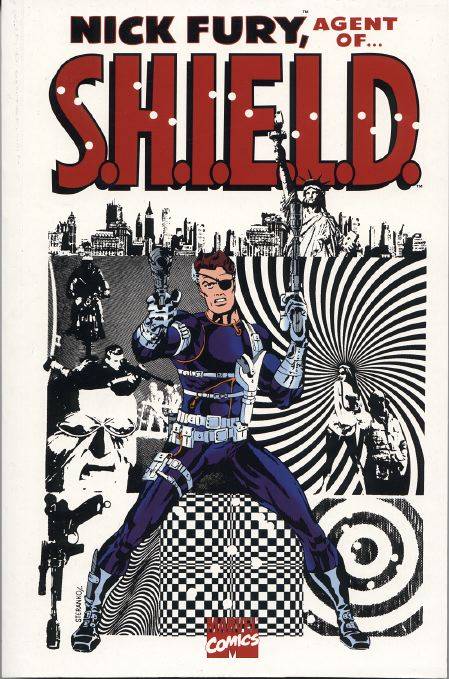Nick Fury, Agent of S.H.I.E.L.D.
by Jim Steranko, Stan Lee, Jack Kirby, and John Buscema
Marvel Comics, TPB, © 2000
Reviewed July 2000
 This collection was issued in 2000 amidst some controversy involving Marvel shutting writer/artist Jim Steranko out of the reprint process (Steranko suggested that he could have contributed better copies of the pages and more ably aided in the reproduction than anyone else - probably a reasonable claim), as well as printing the book in Italy and thereby supposedly denying Steranko reprint royalties. I can't speak to the validity of any claims on this subject, but it I feel that the final package, with some spiffy computer-separated colors, looks pretty nice.
This collection was issued in 2000 amidst some controversy involving Marvel shutting writer/artist Jim Steranko out of the reprint process (Steranko suggested that he could have contributed better copies of the pages and more ably aided in the reproduction than anyone else - probably a reasonable claim), as well as printing the book in Italy and thereby supposedly denying Steranko reprint royalties. I can't speak to the validity of any claims on this subject, but it I feel that the final package, with some spiffy computer-separated colors, looks pretty nice.
Collecting the S.H.I.E.L.D. stories from Strange Tales #150-168 from the late 60s, these are James Bond-style spy stories involving World War II veteran Nick Fury heading up an international spy directorate, and facing a resurgent Hydra (the equivalent of Bond's Spectre) and the forces of the megalomaniacal Yellow Claw. The stories feature death-defying acts, last-minute rescues, more futuristic technology than you can shake a stick at, and the trademarked "pulse-pounding" dialogue by Lee and Steranko.
This work by Steranko (who writes and draws all but the first few stories) is touted as one of the early influences of the commercial art world on comic books, along with Neil Adams' eponymous efforts. But I must admit that I do not see, 30+ years later, exactly what all the fuss was about.
Story-wise, these are the usual entertaining, but lightweight and plausibility-straining, stories that Marvel did so well in the 60s. As Captain Kirk did on Star Trek, Fury sends himself into the high-risk situations and rarely (if ever) trusts his lieutenants (never mind the presumably thousands of trained professionals under them) with important jobs. Fury is, after all, the director of S.H.I.E.L.D., not merely an "agent". The conflicts are good and evil, black and white, with a little misdirection here and there to keep the reader guessing.
The art? Well, the art is very good, to be sure, but the influence of Jack Kirby is unmistakable on every page in the book, and though the layouts might be a little more complex, the characters a tad more distinctive-looking, the improvement over Kirby's work is incremental at best.
All of which is only to say that I don't see this work as being "revolutionary" at this point in time (whereas Spider-Man, for instance, was clearly breaking new ground when it was first published, and even today its earliest issues feel fresh). But it is a fun ride full of plenty of fine artwork (including a four-page spread which has been very nicely presented in this collection), and entertaining stories. It's worth a read for fans of this kind of story, or of Marvel Comics of that era.
hits since 24 August 2000.
|



